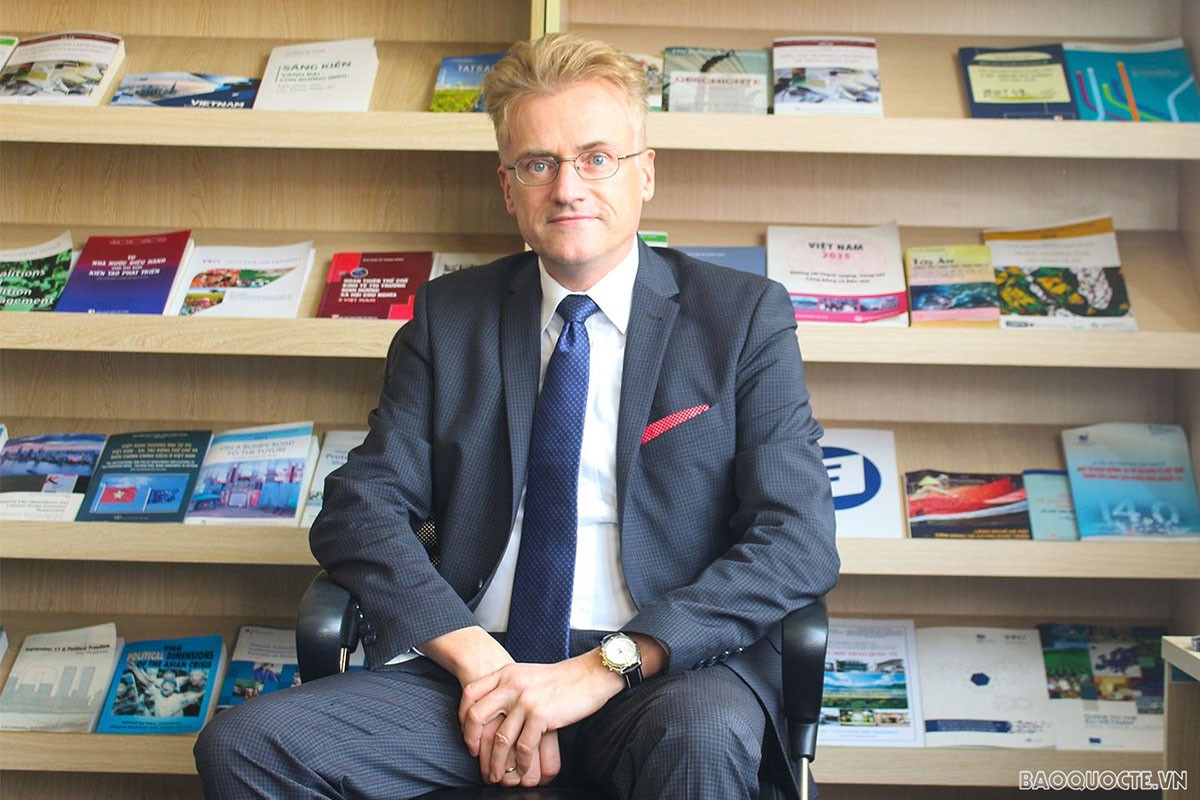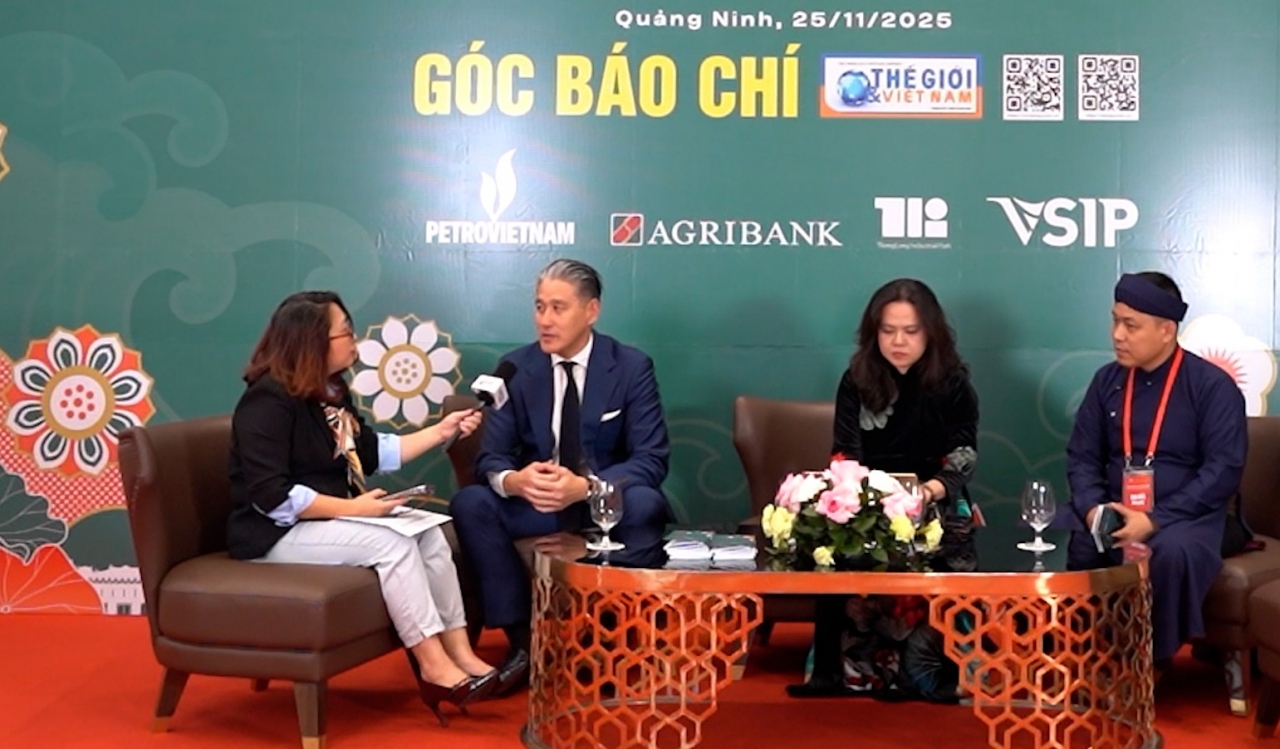
Vietnam's economy in the rising era (Part I):
Continuing the journey of making its mark on the world
Latest
With the position and strength accumulated over nearly 40 years of Doi Moi, now is the ripe moment for Vietnam to enter a new era-an era of national growth. This is also an inevitable step, aligned with the developmental momentum of Vietnam's revolution and the global trends of the times.
 |
| Prof. Dr. Andreas Stoffers. (Photo: Linh Chi) |
On this topic, a reporter from The World and Vietnam Report had a conversation with Prof. Dr. Andreas Stoffers of the University of Applied Sciences for Economics and Management (FOM). A scholar with many years of research on Vietnam's economy and history, Dr. Stoffers regards the S-shaped country as his second homeland and holds a deep affection for this land.
After 38 years (1986–2024) of implementing the Doi Moi policy, Vietnam has transitioned from a centrally planned economy to a market mechanism. Simultaneously, the country has proactively and comprehensively integrated into the global economy, accelerating industrialization and modernization. As an expert with many years of research on Vietnam's economy, how would you evaluate the country’s 38-year journey?
Vietnam's 38-year journey is indeed impressive. From being one of the poorest nations in the world, Vietnam has transformed into an economic powerhouse, poised to become an industrialized nation within the next two decades.
Vietnam has successfully escaped the status of an underdeveloped country to become a dynamic, well-integrated market economy with consistently high and inclusive growth, ensuring the majority of the population benefits from development.
Notably, between 1993 and 2024, the poverty rate in Vietnam dropped significantly. According to data from the Ministry of Labour, Invalids, and Social Affairs, by the end of December 2024, the multidimensional poverty rate was reduced to below 1.9%.
| One of Vietnam's most remarkable recent transformations is the initiative by General Secretary To Lam to streamline the administrative apparatus. I believe this will be the key to the country's development, including its goal of becoming an industrialized nation and building a robust green financial system. |
The economy has not only grown in scale but also improved in quality, with significant enhancements in the material and spiritual lives of its people. Specifically, economic growth has reached a high rate.
After the initial phase of Doi Moi (1986 - 1990), the average annual GDP growth rate was only 4.4%. Between 1991 and 2019, GDP growth ranged between 4.8% and 9.5%. During the Covid-19 pandemic, unlike many countries, Vietnam's GDP continued to grow positively, reaching 2.91% in 2020 and 2.58% in 2021. After a swift recovery in 2022 (with an 8.02% growth rate), GDP in 2023 reached 5.05%, a relatively high level compared to global and regional averages.
When discussing Vietnam's Doi Moi in 1986, most foreign observers have noted that these reforms came virtually overnight, the rapid rise of Vietnam's economy began immediately after. However, as an expert on Vietnam's history and economic development, I can affirm that market-oriented economic activities had already begun at grassroots levels before 1986. That was the merit of the 6th Congress of the Communist Party of Vietnam, which was accepted by the people and turned to reform. Success did not come out of the blue.
In fact, inflation reached astronomical heights after the initial period of Doi Moi, as I detailed in my book “Danh Bai Lam Phat”, published by Women’s Publishing House in 2024. However, market-oriented economic reforms gained significant momentum in the following decades, supported by the normalization of trade relations with the U.S. and the overall economic development.
Despite the severe aftermath of the devastating Typhoon Yagi in September 2024, decisive actions by the Vietnamese Government mitigated the impact of the strongest storm in history on economic growth. Data from the General Statistics Office (under the Ministry of Planning and Investment) demonstrates this, with GDP growth estimated at 7.09% in 2024 with a forecast of 8-8.5% in 2025f, making Vietnam one of the fastest-growing nations in ASEAN.
What’s particularly fascinating is that Vietnam’s journey of making its mark on the world is, it seems, not yet over!
 |
| Vietnam is a dynamic economy that offers attractive opportunities for investors from around the world. (Source: VGP) |
During its process of renovation and international economic integration, Vietnam has developed comprehensively across multiple levels and in diverse forms, signing numerous new-generation bilateral and multilateral free trade agreements (FTAs). Could you highlight the key achievements of Vietnam’s economy in its international integration? What has impressed you the most?
In the 2024 Annual Report on the Index of Economic Freedom by the Heritage Foundation (U.S.), Vietnam was classified as a country with "moderate economic freedom," ranking 59th out of 179 nations.
At first glance, this ranking might not seem extraordinary, especially when compared to developed economies like the U.S., which ranks 25th. However, the remarkable point is that since the report was published 30 years ago, no country of a comparable size (except Poland) has recorded higher growth than Vietnam. The "S-shaped" country rose 13 places in just one year (from 2023 to 2024).
Today, Vietnam stands as one of the most dynamic economies and offers attractive opportunities for investors from all over the world. The country is also recognized as a global bright spot in leveraging opportunities from newly formed supply chains, creating new growth momentum for the economy.
| Vietnam's 38-year journey is indeed impressive. From being one of the poorest nations in the world, Vietnam has transformed into an economic powerhouse, poised to become an industrialized nation within the next two decades. |
In 2024, Vietnam's economic policies have the following key features:
First, Vietnam effectively manages relationships with major powers, ensuring independence, self-reliance, and sovereignty in international integration (e.g., the "bamboo diplomacy").
Second, the country continues to maintain openness to foreign direct investment from around the world.
Third, clear commitments to free trade and integration are evident through a network of FTAs with many countries worldwide.
Fourth, the public debt ratio is balanced and manageable.
Final, public expenditure accounts for approximately 21% of GDP.
One of the most remarkable highlights of Vietnam’s economy this year is its trade performance. Vietnam’s total export-import value reached USD 786.29 billion, a 15.4% increase compared to the previous year, with a trade surplus of USD 24.77 billion—the highest trade volume in its history.
This success is thanks to the efforts in international economic integration, market expansion, and connecting businesses with global partners.
A standout achievement of Vietnam in 2024 was the signing of the Vietnam-UAE Comprehensive Economic Partnership Agreement (CEPA) in a record short negotiation time of only 16 months. This agreement has successfully unlocked major potential markets in the Middle East and Africa and further promoted Vietnam’s global trade integration.
 |
| Prime Minister Pham Minh Chinh and Vice President cum Prime Minister of the United Arab Emirates, Mohammed bin Rashid Al Maktoum, witnessed the signing ceremony of the CEPA Agreement. (Photo: Duong Giang) |
How do you evaluate Vietnam's economic transformation in recent years in terms of digital transformation, green transition, and innovation?
Vietnam's recent economic transformation is marked by significant strides in green finance, digitalization, and innovation. These are some key figures that highlight Vietnam's progress in green finance:
From 2017 to 2023, green credit outstanding in the banking system grew at an average annual rate of 22%.
As of March 31, 2024, 47 credit institutions reported green credit balances totaling VND 636.96 trillion (~USD 25.02 billion), accounting for 4.5% of total credit in the economy.
By the end of 2023, most green credit was concentrated in renewable energy (45%) and green agriculture (30%).
Loans assessed for environmental and social risks steadily increased, reaching VND 2.9 quadrillion (~USD 113.9 billion), or over 21% of total credit outstanding.
From my perspective, green finance is not yet considered part of daily life in the Vietnamese financial industry. However, many progresses can be recognized.
The Vietnamese Government has recognized the vital role of digitalization and is preparing for the 21st century. Key strategies include: Approving the Digital Infrastructure Strategy to 2025, with a vision for 2030 (October 9, 2024); Issuing the National Strategy on application and development of blockchain technology to 2025, orientation to 2030 (October 22, 2024).
 |
| The wind power project on Phu Quy Island, Binh Thuan Province. (Source: Thanh Nien Newspaper) |
The recent plan to put nuclear power plants into operation to help stabilize energy is an extremely appropriate decision. As an industrializing nation, Vietnam requires a secure and reliable energy supply. While solar and wind power alone cannot meet demand, nuclear energy fills the gap to ensure stable energy security for the country.
The critical task now is turning words into actions. Digital transformation, the Fourth Industrial Revolution, smart city development, and green finance are still in their early stages in Vietnam and will certainly require support from both domestic and international experts in science and business.
One of Vietnam's most remarkable recent transformations is the initiative by General Secretary To Lam to streamline the administrative apparatus. I believe this will be the key to the country's development, including its goal of becoming an industrialized nation and building a robust green financial system.
I want to emphasize that General Secretary To Lam’s visionary ideas and leadership are guiding Vietnam in the right direction. These critical structural changes mean Vietnam can and will take an important step forward, becoming an industrialized nation by 2045.
Sincerely thank you!
Stay tuned for Part II: Accumulating great 'assets', confidently rising ahead













